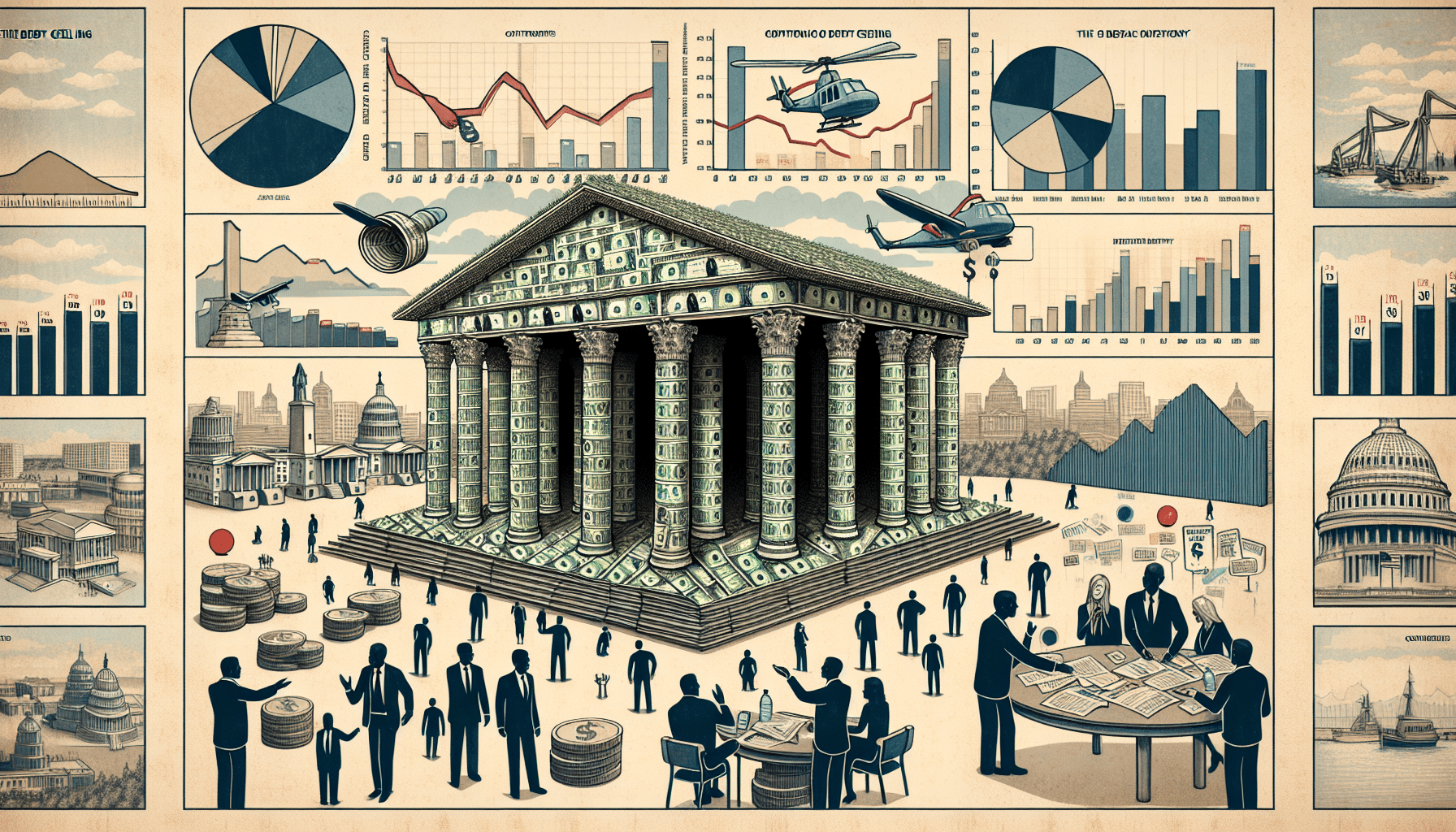In this intriguing article, you will discover the answer to the burning question on everyone’s mind: What is the US debt ceiling? As an informed reader, understanding this crucial concept is essential in comprehending the intricacies of the American economy and its impact on the global financial landscape. Dive into the fascinating world of fiscal policy and gain insight into the significance of the US debt ceiling.

Understanding the US Debt Ceiling
In order to fully grasp the significance of the US debt ceiling, it is important to have a clear understanding of what it entails. Put simply, the debt ceiling refers to the maximum amount of money that the government is legally allowed to borrow to meet its financial obligations. It acts as a cap on the total amount of debt that the United States government can accumulate.
Definition of the US debt ceiling
The US debt ceiling is a statutory limit imposed on the total amount of debt that the US government can issue to finance its operations. It is set by Congress and serves as a barrier that prevents the government from overspending and accumulating excessive debt.
How it came into being
The concept of the debt ceiling came into existence with the passage of the Second Liberty Bond Act of 1917. This act was enacted to provide financing for the United States’ involvement in World War I. It authorized the issuance of government bonds to fund war efforts and set the initial limit on debt issuance.
Its role in U.S. financial infrastructure
The debt ceiling plays a crucial role in the US financial infrastructure by acting as a mechanism to control the government’s spending and borrowing. It serves as a check and balance, ensuring that the government does not accumulate an unsustainable level of debt. By establishing a limit on borrowing, the debt ceiling encourages fiscal responsibility and forces Congress to make difficult decisions about spending priorities.
The History of the US Debt Ceiling
To understand the evolution of the US debt ceiling, we need to delve into its historical origins and subsequent modifications.
Origins in the Liberty Bond Act of 1917
The roots of the debt ceiling can be traced back to the Liberty Bond Act of 1917. This legislation was enacted to fund the US involvement in World War I. It introduced the notion of a debt limit and set the initial cap on government borrowing.
Changes and updates throughout the 20th century
Throughout the 20th century, the debt ceiling underwent numerous changes and updates in response to economic and political circumstances. As the United States faced various challenges, including wars, economic crises, and increased government spending, the debt ceiling was continually revisited and adjusted.
Notable increases and decreases
Over the years, there have been several instances of notable increases and decreases in the debt ceiling. American lawmakers have often raised the ceiling to avoid defaulting on obligations and to provide flexibility for government spending. Notable increases have occurred during periods of economic downturns, wars, and major policy initiatives, while decreases have been relatively rare.
Legal and Constitutional Aspects
The US debt ceiling has significant legal and constitutional implications that shape its implementation and consequences.
Enactment through the Second Liberty Bond Act
The debt ceiling was initially established through the passage of the Second Liberty Bond Act. This legislation gave the US Treasury the authority to issue bonds to fund war efforts and set the maximum limit on debt issuance. Since then, the debt ceiling has been incorporated into subsequent laws and has become an integral part of the US financial system.
Legal implications of exceeding the debt ceiling
Exceeding the debt ceiling has legal ramifications for the US government. When the debt limit is surpassed, the Treasury Department must take extraordinary measures to continue meeting its financial obligations. This includes employing accounting maneuvers, such as suspending the issuance of certain types of debt or tapping into various government accounts, to avoid defaulting on debt.
The 14th Amendment and its relevance to the debt ceiling
The 14th Amendment of the United States Constitution has been a topic of debate concerning its implications for the debt ceiling. The relevant section states that the validity of the government’s debt “shall not be questioned.” Proponents argue that this clause gives the government the authority to borrow and repay its debts, regardless of any statutory debt limits imposed by Congress.
Implications of the Debt Ceiling
The debt ceiling has far-reaching implications for the US economy, the federal government, and international markets and trade.
Effects on the economy
The debt ceiling can have a direct impact on the US economy, as it affects the government’s ability to finance its operations and programs. Failure to raise the debt ceiling can lead to a government shutdown, causing disruptions in vital services and payments to government employees and contractors. Additionally, the uncertainty surrounding the debt ceiling can negatively influence consumer and investor confidence, potentially leading to market volatility.
Consequences for the federal government
When the debt ceiling is reached, the federal government must resort to extraordinary measures to ensure the continuity of its functions. These measures often involve delaying payments, furloughing federal employees, and cutting back on services. This can have significant repercussions, as it threatens the stability of government operations and can undermine public trust in the government’s ability to manage its finances effectively.
Possible repercussions for international markets and trade
The debt ceiling debate in the United States has the potential to impact international markets and trade. The US dollar holds a privileged position as the world’s reserve currency, and any uncertainty or instability in the US financial system can reverberate globally. International investors and countries that hold US Treasury securities may become concerned about the United States’ ability to meet its financial obligations, leading to increased borrowing costs and potential disruptions in global financial markets.

Process of Increasing the Debt Ceiling
The process of increasing the debt ceiling involves the collaboration of Congress and the President, and it follows a specific mechanism.
Role of Congress
As the branch of government responsible for fiscal policy, Congress plays a key role in determining the debt ceiling. Under normal circumstances, Congress must pass legislation to raise the debt ceiling and authorize the government to incur more debt. This requires the approval of both the House of Representatives and the Senate.
Role of the President
Although the decision to raise the debt ceiling ultimately lies with Congress, the President also plays a role in the process. The President typically requests an increase in the debt ceiling through formal letters and negotiations with congressional leaders. However, the President does not have the power to unilaterally raise the debt ceiling without congressional approval.
Mechanism of implementing increase
When Congress approves an increase in the debt ceiling, the Treasury Department can issue new debt to meet the government’s financial obligations. This involves selling Treasury securities, such as Treasury bonds, notes, and bills, to investors both domestically and internationally. The proceeds from these securities offerings are used to fund government operations, pay off existing debt, and manage cash flow needs.
Controversies Surrounding the Debt Ceiling
The debt ceiling has long been a subject of controversy in political discourse, with various criticisms and concerns raised regarding its implications and effects.
Debt ceiling debate in political discourse
The debate surrounding the debt ceiling has become highly politicized, as lawmakers often use it as a bargaining chip to advance their policy priorities. Political parties and ideological factions within Congress have clashed over the appropriate level of government spending, leading to heated discussions and protracted negotiations during debt ceiling debates.
Criticism and concerns related to the debt ceiling
The debt ceiling has faced criticism from economists, policymakers, and experts who argue that it is an arbitrary and ineffective tool for controlling government debt and spending. Critics contend that it creates unnecessary uncertainty and volatility in financial markets and undermines the United States’ ability to meet its financial obligations.
Cases of governmental shutdowns due to debt ceiling debates
The debt ceiling has, in some cases, led to governmental shutdowns when Congress fails to reach an agreement to raise the limit. This can result in the temporary closure of federal agencies and services, causing disruptions in the economy and affecting public perception of the government’s ability to function.

Notable Debt Ceiling Crises
Over the years, the United States has experienced several notable debt ceiling crises that have had significant implications for the economy and government operations.
2011 debt ceiling crisis
One of the most significant debt ceiling crises occurred in 2011 when the United States came dangerously close to defaulting on its debt obligations. The prolonged political standoff between lawmakers led to increased market volatility and a downgrade in the US credit rating by one of the major credit rating agencies.
2013 crisis and government shutdown
In 2013, another debt ceiling crisis occurred, prompting a 16-day government shutdown. The political stalemate surrounding the debt ceiling debate led to financial uncertainty and economic disruptions, as well as a loss of public confidence in the government’s ability to effectively govern.
Possible future scenarios and predictions
While it is challenging to predict the exact outcome of future debt ceiling debates, it is likely that they will continue to be contentious and politically charged. The United States will face ongoing challenges in managing its debt and financing its operations, requiring careful consideration and negotiation to ensure economic stability.
Alternatives to the Debt Ceiling
Given the controversies and challenges associated with the debt ceiling, there have been discussions about potential alternatives to its current framework.
Abolishing the debt ceiling
Some proponents argue for the complete abolition of the debt ceiling, contending that it is an ineffective and outdated policy tool. They argue that Congress should focus on addressing the underlying causes of government debt and spending instead of relying on an arbitrary limit.
Replacing the debt ceiling with another mechanism
Others propose replacing the debt ceiling with alternative mechanisms that would provide a more sustainable and predictable approach to government borrowing and spending. Ideas include implementing a balanced budget requirement or implementing automatic adjustments to the debt ceiling based on specific economic indicators.
Examples from other countries
Looking to other countries can offer insights into alternative approaches to managing government debt. For instance, countries like Sweden and Canada have implemented debt rules and fiscal responsibility laws that provide a framework for managing debt levels and ensuring fiscal discipline.
Debt Ceiling and Credit Rating
The debt ceiling has a direct impact on the United States’ credit rating and the perception of its creditworthiness in the global financial markets.
Impact on U.S. credit rating
The debt ceiling has the potential to affect the United States’ credit rating, as it calls into question the government’s ability to manage its finances and meet its obligations. If raising the debt ceiling is delayed or becomes uncertain, credit rating agencies may downgrade the United States’ credit rating, leading to increased borrowing costs for the government and potentially impacting interest rates for consumer and business loans.
Credit rating agencies and their role
Credit rating agencies assess the creditworthiness of countries and issuers of debt securities, including the United States government. These agencies evaluate factors such as economic stability, fiscal policy, and debt management practices to assign ratings that indicate the level of risk associated with lending to a particular entity.
Past downgrades and their repercussions
The United States has experienced past credit rating downgrades due to debt ceiling debates and concerns over the government’s ability to manage its debt. Notably, in 2011, Standard & Poor’s downgraded the US credit rating from AAA to AA+, which had significant implications for the financial markets and highlighted the potential consequences of debt ceiling crises.
The Future of the Debt Ceiling
Looking ahead, the future of the debt ceiling remains uncertain, with various challenges and potential policy changes on the horizon.
Predicted challenges
The US debt ceiling will continue to present challenges as the country faces persistent budget deficits and rising levels of government debt. Economic factors, such as interest rate fluctuations and economic growth rates, will also influence the government’s ability to manage its debt and stay within the established limits.
Potential policy changes
Policy changes related to the debt ceiling will likely be influenced by political dynamics and evolving fiscal priorities. Lawmakers may consider reforms to the debt ceiling mechanism, adjustments to the overall budgetary process, or the adoption of new fiscal rules to ensure long-term sustainable debt management.
Impact of economic trends and developments
The trajectory of the US debt ceiling will largely be shaped by the broader economic trends and developments within the country. Factors such as economic growth, inflation, and tax policy will influence the government’s revenues and expenditures, which, in turn, will impact the need for raising or maintaining the debt ceiling.
In conclusion, the US debt ceiling has a complex history and serves as a crucial component of the country’s financial infrastructure. It has legal implications, impacts the economy and federal government, and has global repercussions. The process of increasing the debt ceiling involves the collaboration of Congress and the President, and controversies surrounding the debt ceiling persist. A close examination of past debt ceiling crises, possible alternatives, and the relationship between the debt ceiling and credit rating provides valuable insights into the challenges and future of this crucial aspect of US fiscal policy.


